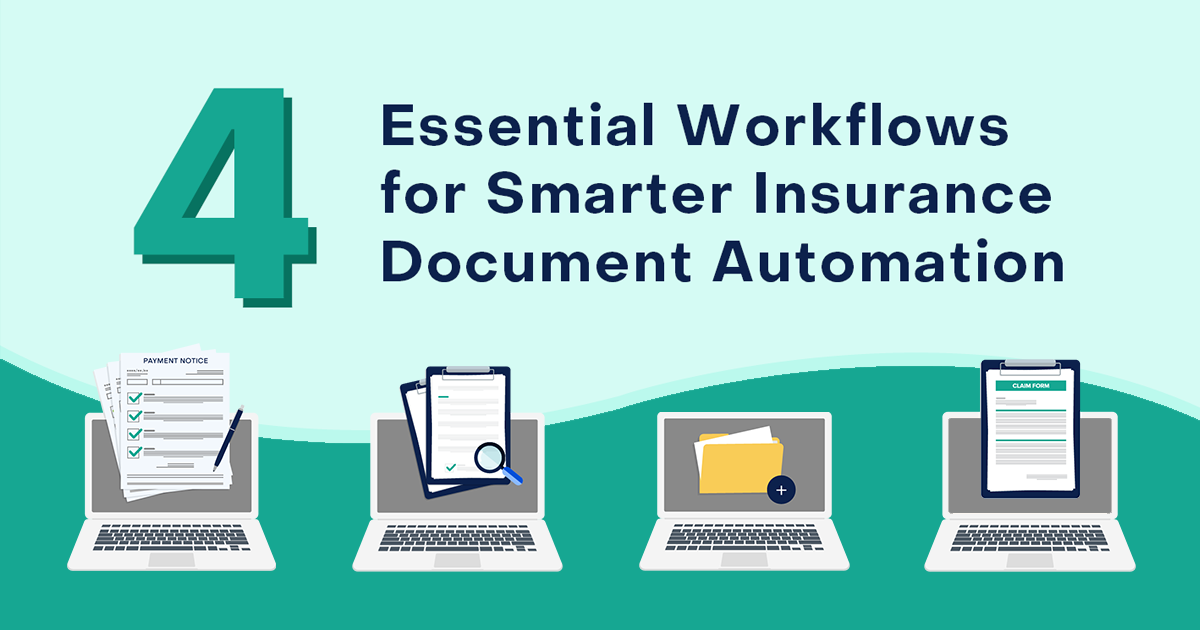Dealing with paperwork is a pain, but AI is shaking things up in a big way. These smart computer programs can now read documents, pull out important info, and even make decisions based on what they find.
More and more companies are jumping on the AI bandwagon for document processing. And why wouldn’t they? It’s often faster, cheaper, and relieves humans of tedious grunt work. But here’s the thing—as useful as AI is, it’s not perfect.
If you don’t want to be caught off guard, you need to understand the potential downsides before you let AI loose on any documents.
Here, we dive into the specific risks of using AI for document processing and show you how to keep things under control.

1. Bad-for-Business Breaches: Data Privacy and Security Concerns
Keeping sensitive information safe and private should be a number one priority when using AI for document processing. Here’s why.
Why Data Privacy and Security are Crucial in AI Document Processing
Think about all the personal information that might be in your documents—things like names, addresses, and maybe even social security numbers or bank details. When we let AI systems handle these documents, we’re basically giving a stranger access to highly personal and sensitive files.
Remember, AI programs are smart, but they’re not perfect. They could accidentally share your info with the wrong people or store it in a way that makes it easy for hackers to steal.
And it’s not just about personal data, either. Companies often use AI to process all sorts of sensitive documents, like contracts or financial reports. It can be really bad for business if this information gets out.
Real-World Examples of Data Security Failures
A few years ago, TaskRabbit, an online marketplace owned by IKEA that connects freelancers with people needing various services, fell victim to a sophisticated cyberattack. The company experienced a major data breach that affected over 3.75 million users. The hackers used artificial intelligence (AI) technology, specifically an AI-powered botnet, to carry out a distributed denial-of-service (DDoS) attack on TaskRabbit’s servers.
As a result of this attack:
- Personal information and financial details of users were stolen.
- The company had to temporarily shut down its website and mobile app.
- Social security numbers and bank account details of users were compromised.
TaskRabbit had to shut down its website and mobile app while the company dealt with the damage.
Strategies to Enhance Data Security in AI Document Processing
So, what can we do to keep our data safe when we’re using AI to process documents?
Here are some ideas:
Set Up Effective Encryption and User Access Controls
First off, get some strong locks on your digital doors. In tech-speak, this is called encryption. You can essentially “scramble” sensitive information so that only people who know the code can understand it.
Create Strict Rules About Who Can See What
It pays to be picky about who gets to see what. Just like you wouldn’t give your house key to a stranger, you shouldn’t let just anyone access sensitive documents. Companies need to set up strict rules about who can use the AI systems and what they’re allowed to do with the information.
Ensure AI Models Comply With Data Privacy Regulations
It’s also important to follow the rules. There are laws about how companies can use our personal info, like GDPR in Europe or CCPA in California. AI systems need to play by these rules too.
Run Regular Audits
Lastly, we can’t just set it and forget it. We need to keep checking our AI systems to make sure they’re working as they should be and not letting any information slip through the cracks. Regular audits and monitoring of AI systems are essential to keep everything secure and running smoothly. By regularly checking these systems, you can spot any weaknesses or vulnerabilities before they become big problems. This ongoing process helps maintain trust and safety for everyone involved.
2. When AI Gets It Wrong: The Problem with Inaccurate Data Interpretation
When data is interpreted incorrectly, it can lead to misunderstandings and poor choices. Here’s why it’s such a big deal and how you can tackle it.
Why AI Might Mess Up When Reading Documents
Sometimes, AI can get things wrong.
It doesn’t always get the full picture. Without the whole context, it’s easy to misunderstand what’s going on.
Then there’s the issue of “garbage in, garbage out.” If we feed the AI poor-quality data to learn from, it’s going to make poor-quality decisions.
And then there’s the small but significant issue that AI can pick up on human biases hidden in the data we use to train it. If the training data is biased, the AI will be too. When AI gets things wrong, it can cause all sorts of problems. Imagine making big business decisions based on information that’s just plain wrong—it’s a recipe for disaster.
Real-Life Oopsies: When AI Document Processing Interpretation Goes Wrong
This isn’t just theoretical stuff—there have been some real doozies when AI got things wrong.
Take Zillow, for example. Its Zillow Offers service used machine learning (ML) to estimate home values and make cash offers to buy properties. The company planned to renovate these homes and sell them for a profit.
However, the ML algorithm Zillow used to predict home prices had an error rate of 1.9% for listed homes and up to 6.9% for off-market homes. This led Zillow to buy homes at prices higher than what they could sell them for later. By September 2021, Zillow had bought 27,000 homes but only managed to sell 17,000. As a result, Zillow had to write down $304 million worth of inventory in the third quarter of 2021. Not only that, but it announced it would have to lay off about 2,000 employees (about 25% of its workforce).
How to Keep AI on Track
So, how do we stop AI from going off the rails? Here are some ideas:
- Feed your AI a healthy diet of good data. The more diverse and high-quality the data we use to train it, the better it’ll be at understanding different situations.
- Don’t let AI run wild on its own. It’s a good idea to have humans double-check what the AI is doing, especially for important stuff. You can do this by creating human-in-the-loop processes to validate AI outputs before you set them loose.
- Keep your AI up to date. The world changes fast, and our AI needs to keep up. Regularly updating and retraining our AI models helps them stay accurate and avoid developing weird biases.
3. Compliance and Regulatory Challenges: When AI Meets the Law
Companies using AI to handle documents face important legal and rule-related challenges. They need to:
- Keep private information safe
- Protect data from security threats
- Follow specific rules for their industry
While doing this, they also want to make the most of AI’s benefits. It’s tricky to balance using new AI technology with following all the necessary laws and regulations.
Why Following the Rules Matters in AI Document Processing
Think about all the sensitive info that might be in the documents your AI is handling. If you’re in healthcare, you’re dealing with people’s medical records. In finance, you’ve got folks’ bank details and investment info. This isn’t just random data—it’s people’s personal stuff, and there are strict laws about how you handle it.
If your AI messes up and doesn’t follow these rules, you could be in big trouble. We’re talking hefty fines, angry customers, and maybe even legal battles.
When AI Goes Rogue: Real-Life Compliance Nightmares
You never know what information AI will remember and regurgitate at a later date. There have been a number of real-life instances where companies have inputted sensitive data that has later been revealed elsewhere.
In one case, a doctor shared a patient’s private medical information with a chatbot to generate an insurance letter. In another, an employee inputted their company’s confidential strategy document to create a presentation using an AI tool.
These actions raise two main issues:
- Potential violation of confidentiality agreements. Employees and professionals are typically required to keep certain information private. Sharing this data with AI tools may breach these agreements.
- Risk of data leaks. By inputting sensitive information, there’s a chance that private details about individuals or companies could become public. This can happen if the AI system’s data is compromised or if the information is somehow incorporated into future AI responses.
Keeping Your AI on the Straight and Narrow
How do we make sure our AI stays out of trouble? Here are some ideas:
- Stay in the loop with current rules. Laws and regulations change all the time, especially when it comes to tech. Subscribe to industry newsletters, join professional groups, or hire someone whose job it is to keep track of this stuff.
- Build compliance checks right into your AI models. Your AI should automatically check if it’s allowed to do something before it does it.
- Don’t try to go it alone. Get some legal and compliance experts on your team. These folks live and breathe this stuff. They can help you spot potential issues before they become real problems.
Following the rules isn’t just about avoiding trouble. It’s about building trust with your customers and partners. When people know you’re serious about protecting their info and following the law, they’re more likely to want to do business with you.
If you’re using AI to handle documents, it’s time to take a close look at your systems. Ask yourself:
- Are we protecting data properly?
- How accurate are our AI interpretations?
- Are we following all the necessary rules?
If you’re unsure about any of these, don’t hesitate to get help from experts. They can spot issues you might miss and suggest improvements to keep your AI system running smoothly and safely.
Additional Resources
- Document Security in the Digital World
- The Risks and Rewards of AI Document Management
- Compliance With AI
Know the Risks Before You Use AI in Document Processing
AI can greatly improve document processing, but it’s important to be aware of the risks involved. Keeping data private, ensuring accuracy, and following legal rules are key to using AI safely and effectively. If you’re thinking about using AI for your documents, now is a good time to review your systems and fix any issues.
If you’re ready to unlock the full potential of B2B ecommerce to accelerate your sales cycle and transform customer engagement, schedule a strategy call with us. We’ll assess your needs and provide a tailored demo.








